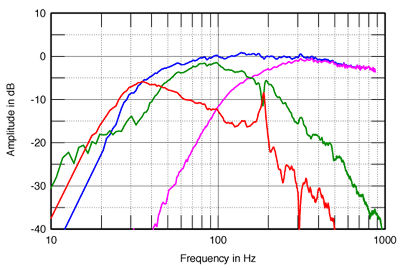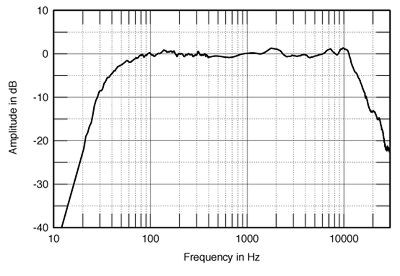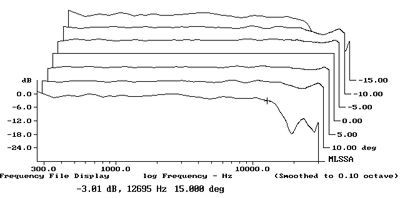| Columns Retired Columns & Blogs |
Burmester Audiosystems B99 loudspeaker Measurements
Sidebar 4: Measurements
Stereophile's reviewers seem to be currently enamored of large, heavy loudspeakers. As with the 270-lb B&W Signature 800 that Kalman Rubinson reviews elsewhere in this issue, it was not possible for me to lift the 220-lb Burmester B99 off the ground for the acoustic measurements. As a result, there was an unavoidable "floor bounce" of the speaker's output that contributed some visible roughness to some of the frequency-response graphs.
I must also comment on the "thinking out of the box" that led Burmester to place the terminals in a recess on the speaker's base. Try as I might, I just couldn't hold the speaker with one hand while I inserted the wires with the other. Of course, at this price level the dealer should do all the work during the speaker's installation, and it could also be fairly pointed out that reviewers are not typical in the amount of plugging and unplugging they do. Nevertheless, I could be heard to let loose with the occasional uncharacteristic cuss word during the measuring session.
Once the cables were hooked up, I estimated the B99's voltage sensitivity as 89.5dB(B)/2.83V/m, which is within experimental error of the specified 90dB. This is a useful 3dB above average. The plot of the speaker's impedance magnitude and phase against frequency (fig.1) reveals the B99 to be moderately difficult for an amplifier to drive, due to a drop to 3.33 ohms in the midrange. However, the electrical phase angle is generally low, meaning that a good amplifier rated at 4 ohms will have no difficulty coping with the speaker.

Fig.1 Burmester B99, electrical impedance (solid) and phase (dashed). (2 ohms/vertical div.)
In the region covered by the ribbon tweeter, the speaker resembles a 7 ohm resistor. Other than a very slight kink at 190Hz, there are no glitches in the impedance traces that would reveal the presence of mechanical resonances. In fact, the B99's enclosure was as dead as the proverbial door nail.
The minimum at 32Hz in the magnitude trace indicates the tuning of the reflex ports, which in turn implies good bass extension. This is confirmed by the plot of the speaker's low-frequency nearfield responses (fig.2). The blue trace is the complex sum of the outputs of the midrange units, woofers, and ports, and can be seen to smoothly roll off with a somewhat overdamped character, reaching a -6dB point at 35Hz. Note that the usual notch in the woofer response at the reflex tuning point is almost absent. As a result, the overall high-pass rolloff is closer to 12dB/octave than the typical reflex system's 24dB/octave. As I explain in the "Measurements" Sidebar that accompanies the B&W 800 review, this type of woofer alignment tends to give, in all but very large rooms, the optimal balance between low-frequency extension and clarity.

Fig.2 Burmester B99, nearfield responses of midrange unit (magenta), woofers (green), port (red), and their complex sum (blue), plotted below 800Hz, 1kHz, 400Hz, and 800Hz, respectively.
The ports' output (red trace) covers the passband between 25Hz and 60Hz, but an otherwise smooth low-pass rolloff is spoiled by the presence of a sharp peak at the same 190Hz seen in the impedance traces. Fortunately, the woofers' response (green) has a suckout at exactly the same frequency, which is why the summed (blue) response is smooth. The crossover between the midrange units and woofers appears to be set slightly lower in frequency than the specified 180Hz, and features symmetrical 12dB/octave slopes.
The same summed nearfield low-frequency curve is shown to the left of fig.3, spliced to the B99's farfield response averaged across a 30 degrees horizontal window on the tweeter axis. It is astonishingly flat, overall! The lack of the usual 3dB "nearfield boost" in the mid- to upper bass, however, suggests that the woofer alignment is perhaps a too overdamped. I note that LG found the speaker's bass to roll off below 25Hz, even with the usual low-frequency "room gain."

Fig.3 Burmester B99, anechoic response on tweeter axis at 50", averaged across 30 degrees horizontal window and corrected for microphone response, with the complex sum of the nearfield responses plotted below 400Hz.
The ribbon tweeter's output appears to roll off sharply above 11kHz or so, which, all things being equal, might be expected to make the speaker's sound lack upper-octave "air." Yet as LG commented on the plentiful air to the B99's balance, perhaps all things are not equal. The missing factor is the speaker's dispersion. Fig.4 shows the B99's lateral radiation pattern (plotted out only to ±15 degrees because I could not maneuver the speaker onto my computer-controlled turntable). The audioband balance doesn't change at all within this window, and the top octave starts to roll off only at the most extreme angle. However, as the output is well-suppressed at the 15 degrees off-axis angles, I suspect that these responses contribute significantly to the rolloff above 11kHz seen in fig.3.

Fig.4 Burmester B99, lateral response family at 50", from back to front: differences in response 15 degrees-5 degrees off-axis, reference response on tweeter axis, differences in response 5 degrees-15 degrees off-axis.
- Log in or register to post comments




































